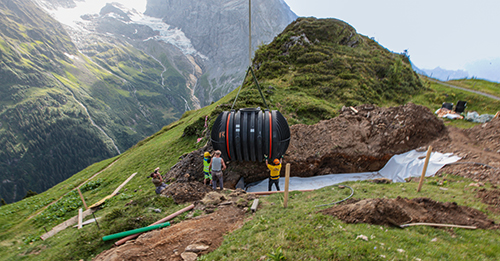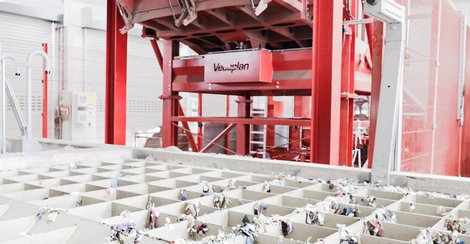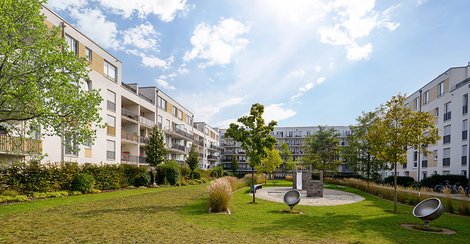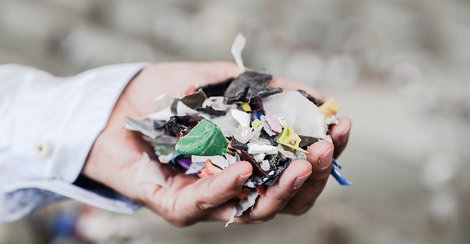Everything KLARO!
One container for wastewater from up to 250 people? KLARO does the maths. The Bayreuth-based specialists from the GRAF Group manufacture, among other things, containerised wastewater treatment plants that are used all over the world.
Every year, 8,000 wastewater treatment plants are built using our technology, helping to purify millions of litres of water’
The white 40-foot container looks like new but has already travelled the world. It was built, loaded, and shipped in Shanghai, then sold in Hamburg. Now it is being converted into one of the most modern small wastewater treatment plants in the world in Bayreuth, Franconia, before it sets off on another long journey. To Sweden, perhaps? To Canada? Or perhaps to the desert? ‘I'm not sure about this one,’ says KLARO Managing Director Tobias Pankse almost apologetically, opening the large doors at the end of the container.
Behind the doors is the machine room of the wastewater treatment plant. A specially developed control system, two powerful air compressors, an air conditioning unit, a control cabinet, the fuse box and various pipes, lines and cables are installed here on a footprint of just under two square metres - because most of the container is used as a clarifier. It is home to the bacteria that do the main work in treating the wastewater - and therefore need to be treated with care.

A whole battery of membrane aerators is installed in two rows at the bottom and, thanks to the air compressors from the engine room, constantly supplies the little helpers with fresh air. A whirlpool for bacteria, if you like - but a very effective one. After 12 hours, the water is so clean that it can be used for irrigation after disinfection. The circular economy. Applied environmental protection with innovative technology from Germany: an export hit.
KLARO wastewater treatment technology is already in use in 80 countries - and treats the wastewater of more than 800,000 people. On major construction sites in Germany, on the edge of mining operations in Australia, in remote regions of Norway and in the remotest parts of the world. ‘Every year, around 8,000 wastewater treatment plants are built using our technology, helping to recycle millions of litres of water,’ says Tobias Pankse, adding: ‘60 to 70 per cent is exported.’ What is important here is that the plants are not only plug-and-play, robust, and durable by design, but can also be controlled remotely.
"Our systems are located in the remotest corners of the world, where technicians are not always available. That's why everything is designed so that our specialist partners can also control their systems over long distances and rectify any faults,’ says Pankse.
The container is just one of many KLARO products. The core business is wastewater treatment technology for small wastewater treatment plants, which we also sell at GRAF together with a tank as a small wastewater treatment plant.

Our plants are in every corner of the world. That's why everything is designed so that our specialist partners can also control the systems over long distances
KLARO, founded in 2009, has been part of our GRAF Group since 2014. The inventive Franconians started out with small wastewater treatment plants, for which GRAF tanks were perfect: a partition wall, a few pipes, the control system and other electronics at a safe distance from the wastewater. A clean solution for small and very small projects. The mountain farm, the research station, the holiday home or the tiny settlement in the Alps: this is exactly what underground tanks with KLARO treatment technology are suitable for. ‘However, if the plants need to be mobile or have to perform better, containers are the first choice,’ says Pankse, who is proud of the fact that KLARO is Europe's market leader for small wastewater treatment plants with SBR technology.
The capacity of wastewater treatment plants is measured by PE, or population equivalent. One inhabitant is one PE, two hotel guests are also one PE. The legislator has decided that all plants with less than 50 PE are considered small wastewater treatment plants and those with up to 500 PE are considered small wastewater treatment plants. It is precisely in this segment that the KLARO containers with 45 to 1380 PE are generally categorised. The containers were developed in 2020 and were immediately well received on the market. As part of the preparatory work for the containers, the partition wall is created to separate the sewage tank and machine room, along with various flaps, flanges and steel strips, after which the container is sealed. In this way, a freight container is transformed into a state-of-the-art wastewater treatment plant. ‘In the past, tanks were built inside containers - but of course this is nowhere near as efficient as simply using the container as a tank,’ explains Product Manager Julian Ulbrich, who supports specialist partners from pretty much all parts of the world in putting KLARO containers into operation. The containerised wastewater treatment plants are available as 10-, 20- and 40-foot containers. ‘We also have the option of connecting up to five containers together,’ explains Ulbrich. ‘Then the new systems from the KLARO MAX series come into play.’ For a university in Bangladesh, a village in Yegang, China, and for a textile factory in South East Asia. ‘We're talking about tanks with more than 1,000 cubic meters of capacity and really big technology that treat the wastewater of over 5,000 people,’ says Ulbrich. ‘At the same time, the plants are proof that our technology is absolutely sophisticated and extremely reliable, even in the face of very large volumes of wastewater.’




